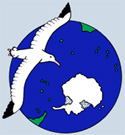 |
WANDERING ALBATROSS
|
 |

|
October 13 2007
|
 We cast off our mooring in Ushuaia not long after dawn on Tuesday and set off down the Beagle Channel, heading for the Falkland Islands.
In the golden light of early morning the town looked almost beautiful, colourful houses against a backdrop of snow-covered mountains.
Strong winds were forecast and we were soon sailing at 7 knts with two reefs in the main and a scrap of jib.
The mountains that have become so familiar over the winter were quickly left behind.
Peale's dolphins played in the bow wave several times on the way down the channel and the further we got towards the open sea, the more birds we saw: Black-browed albatross, Giant petrel and southern fulmars.
We cast off our mooring in Ushuaia not long after dawn on Tuesday and set off down the Beagle Channel, heading for the Falkland Islands.
In the golden light of early morning the town looked almost beautiful, colourful houses against a backdrop of snow-covered mountains.
Strong winds were forecast and we were soon sailing at 7 knts with two reefs in the main and a scrap of jib.
The mountains that have become so familiar over the winter were quickly left behind.
Peale's dolphins played in the bow wave several times on the way down the channel and the further we got towards the open sea, the more birds we saw: Black-browed albatross, Giant petrel and southern fulmars.
|
| |
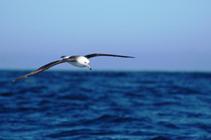 Navigating through the Le Maire Strait between Tierra del Fuego and Isla de los Estados relied on catching the right tide.
Currents run at over 4 knots and if the wind is against the tide then things can get quite nasty.
We timed our arrival at the southern end of the strait for low-water slack and as it happened the wind died altogether.
Under a brilliant canopy of stars we motored through overnight and could hear dolphins puffing beside us in the darkness.
The sun rose to reveal the jagged skyline of Isla de los Estados, lying like a sleeping dragon behind us.
The breeze began to fill in from the west and soon we were broad-reaching under full sail.
Birds were everywhere and as well as the larger albatrosses and petrels we were seeing a lot of Cape petrels, friendly little brown and white birds swooping so close to the transom we could almost touch them.
Prions, too, flitted close to the water, never more than a glimpse of blue-grey flashing past.
Navigating through the Le Maire Strait between Tierra del Fuego and Isla de los Estados relied on catching the right tide.
Currents run at over 4 knots and if the wind is against the tide then things can get quite nasty.
We timed our arrival at the southern end of the strait for low-water slack and as it happened the wind died altogether.
Under a brilliant canopy of stars we motored through overnight and could hear dolphins puffing beside us in the darkness.
The sun rose to reveal the jagged skyline of Isla de los Estados, lying like a sleeping dragon behind us.
The breeze began to fill in from the west and soon we were broad-reaching under full sail.
Birds were everywhere and as well as the larger albatrosses and petrels we were seeing a lot of Cape petrels, friendly little brown and white birds swooping so close to the transom we could almost touch them.
Prions, too, flitted close to the water, never more than a glimpse of blue-grey flashing past.
|
| |
 It was a fast passage with a steady 25 - 30 knts on the beam and at first light two days later we were sailing up the coast of East Falkalnd.
Thousands of Sooty shearwaters streamed past us heading out to sea, presumably from breeding areas in the islands.
Black-browed albatrosses were all around, twisting and turning in the strong wind.
The Falkland Islands are their most important breeding area - about 75% of the world population nests here.
To port the undulating landscape of gently rolling hills and bluffs reminded us of the Orkney islands Scotland where there is a feeling of vast open space, the scraps of land caught between sea and sky.
High clouds were bathed in subtle pastel shades then quickly dispersed and we found ourselves beating up Port William towards Stanley in bright sunshine.
Gleaming sand beaches edged each shore and our first impressions were of a wild and beautiful place.
The houses of Stanley came into view, a cluster of brightly coloured rooves and buildings on a low hillside.
The final approach was through a narrow cut named, not surprisingly, The Narrows, and we sailed all the way into the inner harbour.
It was a fast passage with a steady 25 - 30 knts on the beam and at first light two days later we were sailing up the coast of East Falkalnd.
Thousands of Sooty shearwaters streamed past us heading out to sea, presumably from breeding areas in the islands.
Black-browed albatrosses were all around, twisting and turning in the strong wind.
The Falkland Islands are their most important breeding area - about 75% of the world population nests here.
To port the undulating landscape of gently rolling hills and bluffs reminded us of the Orkney islands Scotland where there is a feeling of vast open space, the scraps of land caught between sea and sky.
High clouds were bathed in subtle pastel shades then quickly dispersed and we found ourselves beating up Port William towards Stanley in bright sunshine.
Gleaming sand beaches edged each shore and our first impressions were of a wild and beautiful place.
The houses of Stanley came into view, a cluster of brightly coloured rooves and buildings on a low hillside.
The final approach was through a narrow cut named, not surprisingly, The Narrows, and we sailed all the way into the inner harbour.
|
| |
 The wind tends to howl down the length of the long, narrow harbour in Stanley and the anchorage off the town is pretty exposed.
Our friends Kate & Hamish on "SEAL" were alongside the public jetty so we tied up next to them, right in the center of the town.
This jetty is normally used to disembark cruise-ship passengers, but it is still early in the season and no ships are due for several weeks.
We felt immediately at home in Stanley - it is typically "British", the streets lined with pretty cottages, daffodils nodding in the wind and several atmospheric pubs!
We will spend a few days here, planning our route around the islands and obtaining permission to visit various Nature Reserves and private land....
The wind tends to howl down the length of the long, narrow harbour in Stanley and the anchorage off the town is pretty exposed.
Our friends Kate & Hamish on "SEAL" were alongside the public jetty so we tied up next to them, right in the center of the town.
This jetty is normally used to disembark cruise-ship passengers, but it is still early in the season and no ships are due for several weeks.
We felt immediately at home in Stanley - it is typically "British", the streets lined with pretty cottages, daffodils nodding in the wind and several atmospheric pubs!
We will spend a few days here, planning our route around the islands and obtaining permission to visit various Nature Reserves and private land....
|
| |
October 20 2007
|
 We've spent most of this week in Stanley, where we've met some great people and familiarised ourselves a bit with the Falkland Islands.
There is no right of access to private land here so we have phoned numerous farmers and landowners to ask permission to visit their property.
The welcome has been fantastic and we already feel a strong bond with these islands!
Around Stanley there are many interesting historic buildings and a number of wrecks, the most prominent of which is the "Lady Elizabeth" (see photo).
Built in 1879, she ran aground off the NE coast in 1913 and after being used as a floating store for over 20 years she was beached in Whalebone Cove at the eastern end of Stanley harbour.
We've spent most of this week in Stanley, where we've met some great people and familiarised ourselves a bit with the Falkland Islands.
There is no right of access to private land here so we have phoned numerous farmers and landowners to ask permission to visit their property.
The welcome has been fantastic and we already feel a strong bond with these islands!
Around Stanley there are many interesting historic buildings and a number of wrecks, the most prominent of which is the "Lady Elizabeth" (see photo).
Built in 1879, she ran aground off the NE coast in 1913 and after being used as a floating store for over 20 years she was beached in Whalebone Cove at the eastern end of Stanley harbour.
|
| |
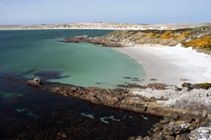 A few hours walk out of Stanley are some beautiful, sandy beaches but unfortunately most of them cannot be accessed due to landmines left over from the conflict with Argentina in 1982.
The dangerous areas are all well marked and on a bright, sunny day we hiked out to Gypsy Cove (see photo).
With the clear, turquoise water and the gleaming sand it seemed almost tropical, apart from the biting wind and the penguins on the sand.
Quite a few Magellanic penguins breed in this area and as we approached we could hear the distinctive, braying calls that give them their local nickname of 'Jackass' penguins.
These are the only Falklands penguins to nest in burrows which they dig in sandy soil.
A few hours walk out of Stanley are some beautiful, sandy beaches but unfortunately most of them cannot be accessed due to landmines left over from the conflict with Argentina in 1982.
The dangerous areas are all well marked and on a bright, sunny day we hiked out to Gypsy Cove (see photo).
With the clear, turquoise water and the gleaming sand it seemed almost tropical, apart from the biting wind and the penguins on the sand.
Quite a few Magellanic penguins breed in this area and as we approached we could hear the distinctive, braying calls that give them their local nickname of 'Jackass' penguins.
These are the only Falklands penguins to nest in burrows which they dig in sandy soil.
|
| |
 A few days later we sailed out to Kidney Island, only 7 miles from Stanley and designated as a Nature Reserve.
It is a small, low lying island covered in mature Tussac Grass which provides important nesting sites for numerous species of birds.
Tussac originally covered large areas around Falkland island coasts but years of livestock grazing means it has disappeared from most of the main islands and now only appears in its original form on the more inaccessible offshore islands.
It is an amazing plant standing several meters tall with long grass blades sprouting from a thick and fibrous pedestal.
Between the closely packed stands of grass a maze of narrow pathways twist and turn, created and used by penguins, seals and shearwaters.
Finding a way through is like creeping through a secret world as the growth is so dense and the plants are well over head height.
A few days later we sailed out to Kidney Island, only 7 miles from Stanley and designated as a Nature Reserve.
It is a small, low lying island covered in mature Tussac Grass which provides important nesting sites for numerous species of birds.
Tussac originally covered large areas around Falkland island coasts but years of livestock grazing means it has disappeared from most of the main islands and now only appears in its original form on the more inaccessible offshore islands.
It is an amazing plant standing several meters tall with long grass blades sprouting from a thick and fibrous pedestal.
Between the closely packed stands of grass a maze of narrow pathways twist and turn, created and used by penguins, seals and shearwaters.
Finding a way through is like creeping through a secret world as the growth is so dense and the plants are well over head height.
|
| |

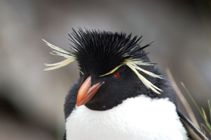 On the north coast of the island we saw Rockhopper penguins for the first time.
They are small penguins with distinctive yellow eye stripes that end in long 'tassles' and bright red eyes.
Over 500 pairs nest on the low cliffs and watching them climb up from the sea was amazing.
They hop with great agility up the steep, rocky slopes, using their beaks to help them and really live up to their name.
It is still very early in the breeding season so there were not yet any eggs, although pairs had formed and stood close together on ledges and next to clumps of Tussac grass.
There are 3 subspecies of Rockhopper penguin and about 75% of the world population of the southern form breed in the Falkland Islands so we will be seeing a lot more of them in the coming months.
On the north coast of the island we saw Rockhopper penguins for the first time.
They are small penguins with distinctive yellow eye stripes that end in long 'tassles' and bright red eyes.
Over 500 pairs nest on the low cliffs and watching them climb up from the sea was amazing.
They hop with great agility up the steep, rocky slopes, using their beaks to help them and really live up to their name.
It is still very early in the breeding season so there were not yet any eggs, although pairs had formed and stood close together on ledges and next to clumps of Tussac grass.
There are 3 subspecies of Rockhopper penguin and about 75% of the world population of the southern form breed in the Falkland Islands so we will be seeing a lot more of them in the coming months.
|
| |

 Back on the beach was a pair of Falkland Island steamer ducks were teaching their 8 ducklings to dive.
This species is endemic to the Falklands and is flightless, with short stubby wings adapted for swimming and diving.
When we first saw them the tiny fluffy ducklings were only able to upend but within an hour they were all ducking under the water and popping up like corks a few moments later.
Back on the beach was a pair of Falkland Island steamer ducks were teaching their 8 ducklings to dive.
This species is endemic to the Falklands and is flightless, with short stubby wings adapted for swimming and diving.
When we first saw them the tiny fluffy ducklings were only able to upend but within an hour they were all ducking under the water and popping up like corks a few moments later.
|
| |
October 30 2007
|
 Its been a week of incredibly mixed weather with strong winds, hail showers, bright sunshine and moments of blissful calm, often all in one day!
Not far north of Stanley lies the privately owned Volunteer Point Nature reserve where the largest population of King Penguins in the Falklands is located.
It is only possible to anchor nearby in settled weather and the exposed bays are prone to big surf, making landing difficult.
As we wanted to spend as much time with the penguins as possible we decided to anchor in a sheltered bay near Johnson Harbour settlement (see photo) and walk the 10 miles to the colony.
The owners, Osmond & Olive Smith, were very welcoming and had kindly arranged for us to stay overnight at the warden's cottage.
The hike over took us about 4 hours and crossed miles of open heathland dotted with little ponds and peat bogs, a wild landscape that once more reminded us of Scotland.
Volunteer Point, seen for the first time on a brilliant afternoon, was one of the most beautiful places we've seen with a long sandy beach, rolling green-blue breakers and the picturesque cottage perched on the hillside.
Its been a week of incredibly mixed weather with strong winds, hail showers, bright sunshine and moments of blissful calm, often all in one day!
Not far north of Stanley lies the privately owned Volunteer Point Nature reserve where the largest population of King Penguins in the Falklands is located.
It is only possible to anchor nearby in settled weather and the exposed bays are prone to big surf, making landing difficult.
As we wanted to spend as much time with the penguins as possible we decided to anchor in a sheltered bay near Johnson Harbour settlement (see photo) and walk the 10 miles to the colony.
The owners, Osmond & Olive Smith, were very welcoming and had kindly arranged for us to stay overnight at the warden's cottage.
The hike over took us about 4 hours and crossed miles of open heathland dotted with little ponds and peat bogs, a wild landscape that once more reminded us of Scotland.
Volunteer Point, seen for the first time on a brilliant afternoon, was one of the most beautiful places we've seen with a long sandy beach, rolling green-blue breakers and the picturesque cottage perched on the hillside.
|
| |
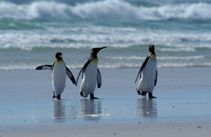 After meeting the hospitable wardens, Pat & Isabel, we wasted no time in setting off to visit the King penguin colony about half a mile away.
Walking along the beach we were constantly giving way to penguins as they came and went to the sea, marching purposefully across the sand.
There is something quite incongruous about seeing penguins on a sandy beach with the clear blue water behind them.
Countless Magellanic penguin burrows pit the turf just behind the beach and there is a small colony of Gentoo penguins further inland.
The Kings were instantly recognisable even at a distance.
They are the second largest penguin, standing almost a meter tall and moving with an aristocratic strut.
After meeting the hospitable wardens, Pat & Isabel, we wasted no time in setting off to visit the King penguin colony about half a mile away.
Walking along the beach we were constantly giving way to penguins as they came and went to the sea, marching purposefully across the sand.
There is something quite incongruous about seeing penguins on a sandy beach with the clear blue water behind them.
Countless Magellanic penguin burrows pit the turf just behind the beach and there is a small colony of Gentoo penguins further inland.
The Kings were instantly recognisable even at a distance.
They are the second largest penguin, standing almost a meter tall and moving with an aristocratic strut.
|
| |

 The Kings are magnificent looking birds with vivid head markings: orange patches on either side that extend down to meet under the chin where they change to yellow and merge into the bright white breast.
In the colony the adult birds were making a wonderful trumpeting call, throwing their heads back and stretching skywards then suddenly arching their necks and bowing their heads down.
Many birds were moulting, shedding their old feathers for new, and stood about in huddled groups on a carpet of feathers.
King penguins have the longest breeding cycle of all seabirds, lasting around 400 days.
In a few weeks time breeding birds will begin laying a single egg, which they incubate on their feet.
The Kings are magnificent looking birds with vivid head markings: orange patches on either side that extend down to meet under the chin where they change to yellow and merge into the bright white breast.
In the colony the adult birds were making a wonderful trumpeting call, throwing their heads back and stretching skywards then suddenly arching their necks and bowing their heads down.
Many birds were moulting, shedding their old feathers for new, and stood about in huddled groups on a carpet of feathers.
King penguins have the longest breeding cycle of all seabirds, lasting around 400 days.
In a few weeks time breeding birds will begin laying a single egg, which they incubate on their feet.
|
| |
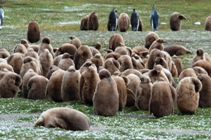
 But it was the chicks that really stole our hearts.
These are last season's chicks, now 9 or 10 months old.
They stand almost as tall as their parents but are covered in thick, brown down which makes them look like big, cuddly teddy bears.
Over the winter they are left in the colony while the parents spend most of their time fishing at sea.
On average the chicks are fed only once every 6 weeks during the winter and a healthy chick may survive up to 5 months without being fed.
They often lose up to 50% of their bodyweight.
All the chicks in the colony cluster together in a tight group known as a creche which helps protect them from predators and adverse weather.
But it was the chicks that really stole our hearts.
These are last season's chicks, now 9 or 10 months old.
They stand almost as tall as their parents but are covered in thick, brown down which makes them look like big, cuddly teddy bears.
Over the winter they are left in the colony while the parents spend most of their time fishing at sea.
On average the chicks are fed only once every 6 weeks during the winter and a healthy chick may survive up to 5 months without being fed.
They often lose up to 50% of their bodyweight.
All the chicks in the colony cluster together in a tight group known as a creche which helps protect them from predators and adverse weather.
|
| |

 For the 2 days we were at Volunteer Point we spent most of the time sitting quietly near the edge of the colony, listening to the musical calls and watching the activity as adults came and went to feed their chicks.
One particular chick was incredibly inquisitive and both days it marched right up to us, followed by a 'gang' of 3 or 4 others that were only slightly shyer.
Close-up their long down looks more like fur than feathers and their eyes were a bright greenish grey.
We found ourselves surrounded by chicks several times and the 'leader' was poking and pecking at everything in sight, including fingers and camera lenses.
We plan to head out west in the next few days to where the large albatross breeding colonies are....
For the 2 days we were at Volunteer Point we spent most of the time sitting quietly near the edge of the colony, listening to the musical calls and watching the activity as adults came and went to feed their chicks.
One particular chick was incredibly inquisitive and both days it marched right up to us, followed by a 'gang' of 3 or 4 others that were only slightly shyer.
Close-up their long down looks more like fur than feathers and their eyes were a bright greenish grey.
We found ourselves surrounded by chicks several times and the 'leader' was poking and pecking at everything in sight, including fingers and camera lenses.
We plan to head out west in the next few days to where the large albatross breeding colonies are....
|
| |
November 7 2007
Pebble Island
|
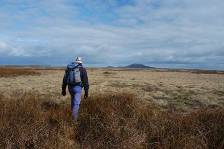 With a long spell of strong southerly winds forecast, we got out of Stanley and made a dash for West Falkland, sailing 90 miles overnight to Pebble Island.
Every half hour or so we had vicious squalls bringing 30 knot plus winds and driving snow.
It wasn't the nicest passage we've ever made and we were glad to reach the shelter of Ship's Harbour at the eastern end of Pebble Island early the next morning.
We had to time our arrival for low water slack to transit the narrow Tamar Pass where the current can run at up to 8 knots.
With a long spell of strong southerly winds forecast, we got out of Stanley and made a dash for West Falkland, sailing 90 miles overnight to Pebble Island.
Every half hour or so we had vicious squalls bringing 30 knot plus winds and driving snow.
It wasn't the nicest passage we've ever made and we were glad to reach the shelter of Ship's Harbour at the eastern end of Pebble Island early the next morning.
We had to time our arrival for low water slack to transit the narrow Tamar Pass where the current can run at up to 8 knots.
 Pebble Island is the 3rd largest offshore island in the Falklands and lies off the northern side of West Falkland.
Long and narrow, it stretches about 19 miles roughly west to east and boasts the longest sand beach in the islands, Elephant Beach, which is 4 miles long and backed by large sand dunes.
The eastern end is very flat and is dotted with numerous ponds and wetland areas, making it an important breeding area for many species of ducks, geese and wading birds.
On the 5 mile hike from our anchorage to the settlement, we passed several of the ponds and spotted White-tufted grebes, Black-necked swans and Speckled Teal.
Pebble Island is the 3rd largest offshore island in the Falklands and lies off the northern side of West Falkland.
Long and narrow, it stretches about 19 miles roughly west to east and boasts the longest sand beach in the islands, Elephant Beach, which is 4 miles long and backed by large sand dunes.
The eastern end is very flat and is dotted with numerous ponds and wetland areas, making it an important breeding area for many species of ducks, geese and wading birds.
On the 5 mile hike from our anchorage to the settlement, we passed several of the ponds and spotted White-tufted grebes, Black-necked swans and Speckled Teal.
|
| |
 Near our anchorage the coast was indented by a series of beautiful little coves.
While the water of the bay was whipped into a frenzy of whitecaps by days of strong winds these coves were well sheltered and it was almost warm in the sun.
Near the shore, Steamer ducks and Upland geese had their nests everywhere.
Careful scanning with the binoculars would reveal the heads of the females as they sat on the eggs, very well hidden in the Diddle-dee bushes (which are a bit like heather), and spotting them was like discovering a special secret.
Near our anchorage the coast was indented by a series of beautiful little coves.
While the water of the bay was whipped into a frenzy of whitecaps by days of strong winds these coves were well sheltered and it was almost warm in the sun.
Near the shore, Steamer ducks and Upland geese had their nests everywhere.
Careful scanning with the binoculars would reveal the heads of the females as they sat on the eggs, very well hidden in the Diddle-dee bushes (which are a bit like heather), and spotting them was like discovering a special secret.
 Some had already hatched and the goslings and ducklings were tiny balls of fluff bobbing on the water, escorted by ever vigilant parents.
On the close cropped turf near the beaches Magellanic oystercatchers were displaying, posturing with their tails fanned high and their long red bills held low to the ground.
Their plaintive, whistling calls sounded constantly.
They lay 2 very well camouflaged eggs, greenish with black markings in a simple scrape in the ground which they incubate for a little over 3 weeks.
Some had already hatched and the goslings and ducklings were tiny balls of fluff bobbing on the water, escorted by ever vigilant parents.
On the close cropped turf near the beaches Magellanic oystercatchers were displaying, posturing with their tails fanned high and their long red bills held low to the ground.
Their plaintive, whistling calls sounded constantly.
They lay 2 very well camouflaged eggs, greenish with black markings in a simple scrape in the ground which they incubate for a little over 3 weeks.
|
| |
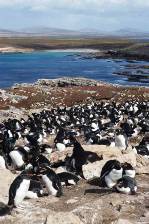 On the first relatively settled day we walked to a mixed Rockhopper penguin and Imperial shag colony on the outer coast of the island, about 4 miles from our anchorage.
Containing thousands of birds on closely packed nests the colony is perched on the edge of the cliff about 75m above the sea.
There is an impression of organised chaos as penguins come and go while shags fly in to their nests.
The noise of raucous greetings fills the air and birds peck aggressively at each other if they encroach on they get too close.
Many of the Rockhoppers now have eggs, which are a very pale blue-green.
They usually lay 2 eggs at a 4-5 day interval but the first is quite a bit smaller than the second and doesn't always hatch.
Incubation will last just over a month and both parents are in attendance for the first ten days or so.
While one bird sits on the eggs in the simple nest of sticks and stones, the other stands close.
After this the male will go to sea to feed, leaving the female to incubate the eggs for a further 10 days or so.
He returns to take the final spell on the nest while the female goes to sea and he guards the chicks when they first hatch.
On the first relatively settled day we walked to a mixed Rockhopper penguin and Imperial shag colony on the outer coast of the island, about 4 miles from our anchorage.
Containing thousands of birds on closely packed nests the colony is perched on the edge of the cliff about 75m above the sea.
There is an impression of organised chaos as penguins come and go while shags fly in to their nests.
The noise of raucous greetings fills the air and birds peck aggressively at each other if they encroach on they get too close.
Many of the Rockhoppers now have eggs, which are a very pale blue-green.
They usually lay 2 eggs at a 4-5 day interval but the first is quite a bit smaller than the second and doesn't always hatch.
Incubation will last just over a month and both parents are in attendance for the first ten days or so.
While one bird sits on the eggs in the simple nest of sticks and stones, the other stands close.
After this the male will go to sea to feed, leaving the female to incubate the eggs for a further 10 days or so.
He returns to take the final spell on the nest while the female goes to sea and he guards the chicks when they first hatch.
|
| |
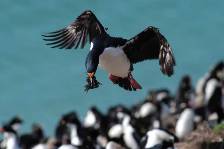 The Imperial shags are handsome with their bright blue eye rings, glossy blue-black plummage and vivid orange knobs at the base of their bills.
Their nests are spaced just far enough apart to be out of pecking range of the next bird, built of mud, diddle-dee twigs, grass and sea-weed.
These accumulations form little pillars about a foot high and at this stage in the breeding season nest maintenance is a priority.
We didn't see any eggs yet, but while one bird sits on the nest, the other brings great clumps of building materials, flying in with bill-fulls so large their heads are sometimes almost hidden.
Coming in to land is an ungainly process involving much flapping of wings and running the gauntlet past other nests, whose inhabitants are only too keen to steal a chunk of nesting material!
The Imperial shags are handsome with their bright blue eye rings, glossy blue-black plummage and vivid orange knobs at the base of their bills.
Their nests are spaced just far enough apart to be out of pecking range of the next bird, built of mud, diddle-dee twigs, grass and sea-weed.
These accumulations form little pillars about a foot high and at this stage in the breeding season nest maintenance is a priority.
We didn't see any eggs yet, but while one bird sits on the nest, the other brings great clumps of building materials, flying in with bill-fulls so large their heads are sometimes almost hidden.
Coming in to land is an ungainly process involving much flapping of wings and running the gauntlet past other nests, whose inhabitants are only too keen to steal a chunk of nesting material!
|
| |
November 13 2007
Saunders Island
|
 From Pebble Island we had a brisk sail to Saunders Island, passing through Pebble Sound and past Keppel Island on a rare day of settled weather - a mere 15 knots from the southwest.
Saunders Island, the second largest offshore island in the Falklands, is a fantastic place with an abundance of wildlife.
For the past 5 days we've been exploring, anchoring in various bays.
But the highlight has definitely been The Neck (see photo), a narrow stretch of low land that almost cuts the island in two.
With a lucky break of almost 48 hrs of very calm wind we were able to anchor on the north side, off the mile long sandy beach, and land the dinghy ashore, normally made difficult by the swell.
From Pebble Island we had a brisk sail to Saunders Island, passing through Pebble Sound and past Keppel Island on a rare day of settled weather - a mere 15 knots from the southwest.
Saunders Island, the second largest offshore island in the Falklands, is a fantastic place with an abundance of wildlife.
For the past 5 days we've been exploring, anchoring in various bays.
But the highlight has definitely been The Neck (see photo), a narrow stretch of low land that almost cuts the island in two.
With a lucky break of almost 48 hrs of very calm wind we were able to anchor on the north side, off the mile long sandy beach, and land the dinghy ashore, normally made difficult by the swell.
|
| |
 Hundreds of Gentoo penguins nest near the beach and spend much time trudging to and fro between their colony and the sea.
For the first time we saw them 'surfing' in the breaking waves as they come ashore and they really seem to be enjoying themselves as they catch a wave, ride it in and burst from the surf in showers of spray.
As they leave the water they tend to congregate in groups to preen and rest (see photo).
Magellanic penguin burrows were everywhere in the sandy soil.
Although these penguins are somewhat shy and secretive they are also quite inquisitive and often peer out of their burrows at you, turning their heads from side to side to look first with one eye and then the other.
On the hillside overlooking the beach was a large colony of mixed Rockhopper penguins and Imperial shags going about their business in raucous chaos.
Rockhoppers love fresh water to drink and bathe in and a little stream running down the hill was a great place to watch them.
Endless squabbles broke out over who's turn it was to splash in a favourite pool and if we sat still for long enough these cheeky little characters sidled right up to us to stare with their bright red eyes.
Hundreds of Gentoo penguins nest near the beach and spend much time trudging to and fro between their colony and the sea.
For the first time we saw them 'surfing' in the breaking waves as they come ashore and they really seem to be enjoying themselves as they catch a wave, ride it in and burst from the surf in showers of spray.
As they leave the water they tend to congregate in groups to preen and rest (see photo).
Magellanic penguin burrows were everywhere in the sandy soil.
Although these penguins are somewhat shy and secretive they are also quite inquisitive and often peer out of their burrows at you, turning their heads from side to side to look first with one eye and then the other.
On the hillside overlooking the beach was a large colony of mixed Rockhopper penguins and Imperial shags going about their business in raucous chaos.
Rockhoppers love fresh water to drink and bathe in and a little stream running down the hill was a great place to watch them.
Endless squabbles broke out over who's turn it was to splash in a favourite pool and if we sat still for long enough these cheeky little characters sidled right up to us to stare with their bright red eyes.
|
| |

 It was a very special moment for us when we saw our first breeding Black-browed albatrosses.
The Falkland Islands are the most important breeding area in the world for these magnificent, but endangered, birds.
An estimated 11,000 pairs nest along the north shore of Saunders Island, spread out in small groups and to sit near a colony and watch these beautiful birds in action was a real privilige.
It was a very special moment for us when we saw our first breeding Black-browed albatrosses.
The Falkland Islands are the most important breeding area in the world for these magnificent, but endangered, birds.
An estimated 11,000 pairs nest along the north shore of Saunders Island, spread out in small groups and to sit near a colony and watch these beautiful birds in action was a real privilige.
|
| |
 Nests are up to a foot high, pillars built of mud and grass spaced just out of reach of the next bird and often perched precariously on the edge of the cliff.
We saw several pairs involved in nest building with one bird sitting on the nest while carefully plastering mud around the edge with its bill while the other bird transported fresh mud and grass to within reach (see photo).
Sometimes this was done over quite a distance and the birds picked up mud piece by piece, tossing it back over their shoulders and then repeating the process again and again.
Although many birds had single, pale cream coloured eggs, we also noticed quite a few empty nests with birds sitting.
These birds often took part in elaborated displays, pairs of birds circling a nest with tails fanned and feet stamping, crooning to each other and touching bills (see photos above).
We surmised that these may be young birds that are not breeding this season but are practicing for next....
For more information on why Black-browed albatrosses are endangered and the campaign to save them, and all albatross species, visit www.savethealbatross.net
Nests are up to a foot high, pillars built of mud and grass spaced just out of reach of the next bird and often perched precariously on the edge of the cliff.
We saw several pairs involved in nest building with one bird sitting on the nest while carefully plastering mud around the edge with its bill while the other bird transported fresh mud and grass to within reach (see photo).
Sometimes this was done over quite a distance and the birds picked up mud piece by piece, tossing it back over their shoulders and then repeating the process again and again.
Although many birds had single, pale cream coloured eggs, we also noticed quite a few empty nests with birds sitting.
These birds often took part in elaborated displays, pairs of birds circling a nest with tails fanned and feet stamping, crooning to each other and touching bills (see photos above).
We surmised that these may be young birds that are not breeding this season but are practicing for next....
For more information on why Black-browed albatrosses are endangered and the campaign to save them, and all albatross species, visit www.savethealbatross.net
|
| |
November 17 2007
Carcass Island
|
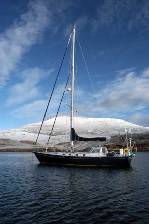
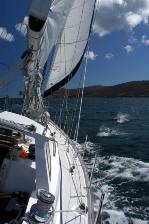 The weather has been unexpectedly cold with lots of hail squalls and on the morning we left Saunders Island we awoke to find a thin covering of snow on the deck and ashore (see photo).
The bright red rooves of the settlement shone in the morning sunshine and within an hour all had melted.
Getting underway in a brisk southerly breeze we sailed up around the north side of the island and out past various reefs to the west.
Strong tidal currents rip around the points and through the narrow channels but we managed to have mostly favourable current as we headed towards Carcass Island, a total distance of about 25 miles.
Every time we are underway we have had dolphins arriving to play in the bow wave, always a joy to watch as they race just ahead of the boat, leaping, twisting and turning.
The weather has been unexpectedly cold with lots of hail squalls and on the morning we left Saunders Island we awoke to find a thin covering of snow on the deck and ashore (see photo).
The bright red rooves of the settlement shone in the morning sunshine and within an hour all had melted.
Getting underway in a brisk southerly breeze we sailed up around the north side of the island and out past various reefs to the west.
Strong tidal currents rip around the points and through the narrow channels but we managed to have mostly favourable current as we headed towards Carcass Island, a total distance of about 25 miles.
Every time we are underway we have had dolphins arriving to play in the bow wave, always a joy to watch as they race just ahead of the boat, leaping, twisting and turning.
|
| |
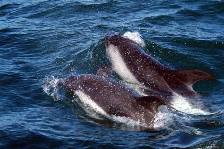 There are two species of doplhin commonly seen in Falkland Islands waters, Peales dolphins and Commersons dolphins.
We have often seen both in one day.
The Commersons dolphin is particularly small and stout looking with striking blaCK and white markings.
They seem very playful, sometimes following us for hours and right into an anchorage where they then swim through the kelp and around the boat.
They make a forceful, puffing blow as they surface.
Peale's dolphins (see photo) are more robust with a high, curved dorsal fin, a blunt beak and dark face.
They don't usually stay as long as the Commersons but today they rode the bow wave for over an hour, zigzagging around and under the hull at great speed and occasionally leaping right out of the water and belly flopping back in.
There are two species of doplhin commonly seen in Falkland Islands waters, Peales dolphins and Commersons dolphins.
We have often seen both in one day.
The Commersons dolphin is particularly small and stout looking with striking blaCK and white markings.
They seem very playful, sometimes following us for hours and right into an anchorage where they then swim through the kelp and around the boat.
They make a forceful, puffing blow as they surface.
Peale's dolphins (see photo) are more robust with a high, curved dorsal fin, a blunt beak and dark face.
They don't usually stay as long as the Commersons but today they rode the bow wave for over an hour, zigzagging around and under the hull at great speed and occasionally leaping right out of the water and belly flopping back in.
|
| |
 Carcass Island is a peaceful place, about 5 miles long and with a crescent shaped bay on the south side, where we anchored close in amongst patches of kelp near the settlement.
Owners Rob & Lorraine McGill run a comfortable lodge and welcomed us with a cup of tea and home-baked cakes.
Carcass is unique amongst the larger offshore islands in that it is free of rodents and cats, allowing small birds such as the endemic Cobbs wren to thrive.
It also has a long history of conservationist owners who have planted large areas of tussac grass over the years, resulting in mature plantations today.
Rowing ashore in the dinghy the first thing we noticed was the sound of birdsong and a constant flitting back and forth of thrushes, finches and tussacbirds.
On the northwest point of the island, about a 3 mile walk from the anchorage, a small number of Southern Elephant seals haul out on a rocky point to breed and molt.
We had never seen these seals before, the largest in the world, and were excited to find about 40 adults and 14 weanlings (this years pups) on the beach.
Carcass Island is a peaceful place, about 5 miles long and with a crescent shaped bay on the south side, where we anchored close in amongst patches of kelp near the settlement.
Owners Rob & Lorraine McGill run a comfortable lodge and welcomed us with a cup of tea and home-baked cakes.
Carcass is unique amongst the larger offshore islands in that it is free of rodents and cats, allowing small birds such as the endemic Cobbs wren to thrive.
It also has a long history of conservationist owners who have planted large areas of tussac grass over the years, resulting in mature plantations today.
Rowing ashore in the dinghy the first thing we noticed was the sound of birdsong and a constant flitting back and forth of thrushes, finches and tussacbirds.
On the northwest point of the island, about a 3 mile walk from the anchorage, a small number of Southern Elephant seals haul out on a rocky point to breed and molt.
We had never seen these seals before, the largest in the world, and were excited to find about 40 adults and 14 weanlings (this years pups) on the beach.
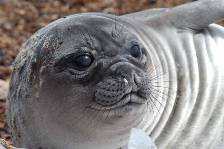 The pups are weaned at about 3 weeks old and abandoned on the beach by their mothers, who return to sea to feed.
They have a beautiful silver grey coat, which will soon darken to a more brown colour, and squashed, pug-like faces with huge eyes (see photo).
The adults were a dull tan and lay like great lumps on the beach, snorting, sneezing and smelling awful!
Young males lumbered into the shallows from time to time to spar, rearing up on the back half of their bodies and lunging at each other (see photo).
This is good practice for maturity, when males must win the right to mate with the females by proving their dominance.
With the wind coming around to the southwest and strengthening, we only had a few days in Carcass before we had to seek better shelter a few miles away at Westpoint Island where there is very protected harbour....
The pups are weaned at about 3 weeks old and abandoned on the beach by their mothers, who return to sea to feed.
They have a beautiful silver grey coat, which will soon darken to a more brown colour, and squashed, pug-like faces with huge eyes (see photo).
The adults were a dull tan and lay like great lumps on the beach, snorting, sneezing and smelling awful!
Young males lumbered into the shallows from time to time to spar, rearing up on the back half of their bodies and lunging at each other (see photo).
This is good practice for maturity, when males must win the right to mate with the females by proving their dominance.
With the wind coming around to the southwest and strengthening, we only had a few days in Carcass before we had to seek better shelter a few miles away at Westpoint Island where there is very protected harbour....
|
| |
November 21 2007
Westpoint Island
|
 Westpoint Island lies only about 5 miles SW of Carcass and with some strong winds on the way we made an early morning jib run across the sound.
Westpoint has a well sheltered harbour but with the GRIB files showing a gale from the northwest closely followed by another from the southwest we decided to haul out our second anchor (see photo).
It took a couple of tries to get it set as there is so much kelp growing in the harbour but once it was in we knew we could sleep well - except, of course, that the worst winds came howling through in the wee hours, giving us a rather restless night.
Westpoint Island lies only about 5 miles SW of Carcass and with some strong winds on the way we made an early morning jib run across the sound.
Westpoint has a well sheltered harbour but with the GRIB files showing a gale from the northwest closely followed by another from the southwest we decided to haul out our second anchor (see photo).
It took a couple of tries to get it set as there is so much kelp growing in the harbour but once it was in we knew we could sleep well - except, of course, that the worst winds came howling through in the wee hours, giving us a rather restless night.
|
| |
 The winds stayed strong for the next few days, a fact of life in the Falklands.
Arriving ashore for the first time we felt that this was a special place for some reason and loved it at once.
The buildings of the settlement sit on the hill overlooking the bay, surrounded by colourful yellow gorse bushes (see photo).
We were welcomed by Roddy Napier, who owns the island and has lived there his whole life.
Now almost 80, Roddy is a wonderful character and we enjoyed many cups of tea in the kitchen hearing stories about the Falklands and island life.
Westpoint has been in Roddy's family since 1879 when his great-uncle, Arthur Felton, first leased the island to farm sheep.
The winds stayed strong for the next few days, a fact of life in the Falklands.
Arriving ashore for the first time we felt that this was a special place for some reason and loved it at once.
The buildings of the settlement sit on the hill overlooking the bay, surrounded by colourful yellow gorse bushes (see photo).
We were welcomed by Roddy Napier, who owns the island and has lived there his whole life.
Now almost 80, Roddy is a wonderful character and we enjoyed many cups of tea in the kitchen hearing stories about the Falklands and island life.
Westpoint has been in Roddy's family since 1879 when his great-uncle, Arthur Felton, first leased the island to farm sheep.
|
| |

 About 2 miles wide and 4 miles long, Westpoint was perfect to explore on foot and we hiked miles across the rolling hillsides.
Spectacular cliffs dominate the western side - plunging several hundred metres into the sea, they are the highest in the Falklands (see photo).
Around 14,000 pairs of Black-browed albatross nest along this coast, spread out in several colonies.
One good thing about the wind is that the birds love it and we watched them for hours as they swooped and soared, often whooshing just yards above our heads with a sound like a distant jumbo jet.
Coming in to land they are not quite so graceful, approaching with their great webbed feet splayed, craning their heads and often thumping down hard on the outskirst of the colony then walking with ungainly, slapping steps to their destination.
About 2 miles wide and 4 miles long, Westpoint was perfect to explore on foot and we hiked miles across the rolling hillsides.
Spectacular cliffs dominate the western side - plunging several hundred metres into the sea, they are the highest in the Falklands (see photo).
Around 14,000 pairs of Black-browed albatross nest along this coast, spread out in several colonies.
One good thing about the wind is that the birds love it and we watched them for hours as they swooped and soared, often whooshing just yards above our heads with a sound like a distant jumbo jet.
Coming in to land they are not quite so graceful, approaching with their great webbed feet splayed, craning their heads and often thumping down hard on the outskirst of the colony then walking with ungainly, slapping steps to their destination.
|
| |
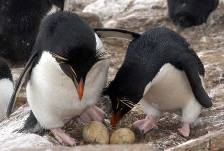 Some of the colonies are mixed Black-browed albatross and Rockhopper penguins, although the albatrosses far outnumber the penguins here.
Beside the enormous albatrosses the Rockhoppers seem tiny but they are aggressive enough to make up for it, thinking nothing of squawking and pecking a vigorous complaint whenever an albatross encroaches on their space.
When it is time for "the changing of the guard" at the nest, the two penguins make numerous harsh calls with heads thrown back to identify each other.
Then the bird that has been sitting steps gingerly away from the eggs while the other leans forward as if inspecting them before quickly moving into position, leaving them exposed for only a brief moment (see photo).
Some of the colonies are mixed Black-browed albatross and Rockhopper penguins, although the albatrosses far outnumber the penguins here.
Beside the enormous albatrosses the Rockhoppers seem tiny but they are aggressive enough to make up for it, thinking nothing of squawking and pecking a vigorous complaint whenever an albatross encroaches on their space.
When it is time for "the changing of the guard" at the nest, the two penguins make numerous harsh calls with heads thrown back to identify each other.
Then the bird that has been sitting steps gingerly away from the eggs while the other leans forward as if inspecting them before quickly moving into position, leaving them exposed for only a brief moment (see photo).
|
| |
November 25 2007
Back to Saunders Island
|
 With an outlook of more strong winds for the next few days we decided to return to Saunders Island where we knew they were about to start shearing several thousand sheep.
We set out from Westpoint in a good 30 knots of northwest wind and had a fast jib run down Byron Sound before negotiating the narrow and tortuous Reef Channel to reach the anchorage off the settlement.
Commersons dolphins followed us all the way through the passage and right into the anchorage.
It was great to watch them swim slowly around us (see photo) and even better when they raced Gary ashore as he went in in the dinghy to say hello to the Pole-Evans family who own the island.
With an outlook of more strong winds for the next few days we decided to return to Saunders Island where we knew they were about to start shearing several thousand sheep.
We set out from Westpoint in a good 30 knots of northwest wind and had a fast jib run down Byron Sound before negotiating the narrow and tortuous Reef Channel to reach the anchorage off the settlement.
Commersons dolphins followed us all the way through the passage and right into the anchorage.
It was great to watch them swim slowly around us (see photo) and even better when they raced Gary ashore as he went in in the dinghy to say hello to the Pole-Evans family who own the island.
|
| |
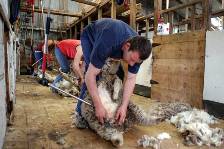 The shearing gang, consisting of 3 shearers and a 'rousie', were due to arrive the next day.
There was a feeling of anticipation as everyone prepared for what would be an intense week of hard work.
Saunders has a flock of about 6500 sheep, half of which were to be sheared now and the rest after they have lambed.
The pens in- and out-side the shearing shed were filled with sheep the night before so that the shearers could get started at once.
We spent a day watching the routine and it was impressive to see the shearers in action, mostly doing a sheep every 2 minutes (see photo).
The rousie had a full time job collecting the fleeces as they came off and carrying them to the sorting table, where they are graded, rolled and put into a machine that presses the wool into bales.
The shearing gang, consisting of 3 shearers and a 'rousie', were due to arrive the next day.
There was a feeling of anticipation as everyone prepared for what would be an intense week of hard work.
Saunders has a flock of about 6500 sheep, half of which were to be sheared now and the rest after they have lambed.
The pens in- and out-side the shearing shed were filled with sheep the night before so that the shearers could get started at once.
We spent a day watching the routine and it was impressive to see the shearers in action, mostly doing a sheep every 2 minutes (see photo).
The rousie had a full time job collecting the fleeces as they came off and carrying them to the sorting table, where they are graded, rolled and put into a machine that presses the wool into bales.
|
| |
 The next day the weather looked reasonable to return to the Neck, our favourite place so far with fantastic birdlife.
With the wind out of the NW we anchored on the south side but in the end had a very rolly night as the swell was following the coastline around and into the bay.
We stayed ashore as much as possible and spent many hours watching the Gentoo penguins.
The colony is spread out over the sandy mounds of the Neck, subdivided into groups of a few hundred nesting pairs.
The close packed nests of stones cover every hummock, making a symmetrical pattern of dark penguin backs against the light sand (see photo).
The next day the weather looked reasonable to return to the Neck, our favourite place so far with fantastic birdlife.
With the wind out of the NW we anchored on the south side but in the end had a very rolly night as the swell was following the coastline around and into the bay.
We stayed ashore as much as possible and spent many hours watching the Gentoo penguins.
The colony is spread out over the sandy mounds of the Neck, subdivided into groups of a few hundred nesting pairs.
The close packed nests of stones cover every hummock, making a symmetrical pattern of dark penguin backs against the light sand (see photo).
|
| |
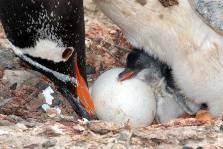 Late in the evening we sat near one group of penguins while we waited for the full moon to come up.
A constant stream of birds was returning from the sea, marching with a purposeful waddle towards their particular nest.
Stretching their bills towards the sky the partners greet each other with a trilling call and the sound of penguins all over the colony crooning loudly to each other is wonderful.
Scanning with binoculars Gary made an exciting discovery - he spotted newly hatched chicks in several nests!
The broken shells were still in the nest and some had one chick and an unhatched egg (see photo).
Gentoos generally produce 2 eggs and although these may be laid up to 4 days apart they hatch within 24 hours.
Late in the evening we sat near one group of penguins while we waited for the full moon to come up.
A constant stream of birds was returning from the sea, marching with a purposeful waddle towards their particular nest.
Stretching their bills towards the sky the partners greet each other with a trilling call and the sound of penguins all over the colony crooning loudly to each other is wonderful.
Scanning with binoculars Gary made an exciting discovery - he spotted newly hatched chicks in several nests!
The broken shells were still in the nest and some had one chick and an unhatched egg (see photo).
Gentoos generally produce 2 eggs and although these may be laid up to 4 days apart they hatch within 24 hours.
|
| |
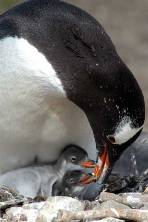 The next morning we returned to look for more chicks.
About a third of the nests now had hatched chicks and they are so tiny and vulnerable as they emerge from the egg.
Their eyes are hardly open and their heads wobble precariously on scrawny necks as if they are too heavy to hold up.
Whenever we found one hatched chick and an egg we knew that the egg would soon be hatching and kept an eye on it, eventually managing to watch one actually hatch.
First a small hole appears with just the little white tipped beak of the chick poking through.
The parent keeps moving the egg and keeping the hole uppermost as it gradually gets bigger and bigger.
At last the shell cracks right open and the tiny, damp chick is revealed, curled tight.
It doesn't take long for it to struggle upright and immediately look for a feed which the parent provides as a regurgitated jelly.
As the penguin bends its head down and opens its bill it seems a very caring and tender gesture (see photo).
Now the hatching has begun it will all happen very fast and the chicks will grow almost before our eyes in the next few weeks....
The next morning we returned to look for more chicks.
About a third of the nests now had hatched chicks and they are so tiny and vulnerable as they emerge from the egg.
Their eyes are hardly open and their heads wobble precariously on scrawny necks as if they are too heavy to hold up.
Whenever we found one hatched chick and an egg we knew that the egg would soon be hatching and kept an eye on it, eventually managing to watch one actually hatch.
First a small hole appears with just the little white tipped beak of the chick poking through.
The parent keeps moving the egg and keeping the hole uppermost as it gradually gets bigger and bigger.
At last the shell cracks right open and the tiny, damp chick is revealed, curled tight.
It doesn't take long for it to struggle upright and immediately look for a feed which the parent provides as a regurgitated jelly.
As the penguin bends its head down and opens its bill it seems a very caring and tender gesture (see photo).
Now the hatching has begun it will all happen very fast and the chicks will grow almost before our eyes in the next few weeks....
|
| |
December 7 2007
Jason Islands & Hope Harbour
|
 We heard that the weather in November was reported by the local paper, the Penguin News, to be the worst in living memory for that month but it seems that summer might finally be here:
The past few days have been sunny and almost warm.
Having returned to Westpoint to spend more time with the Black-browed albatrosses, we took advantage of an almost windless day to visit the Jason Islands which stretch about 30 miles to the west.
Strong tidal currents sweep around these uninhabited islands and there are no secure anchorages but they hold the largest Black-browed albatross colony in the world which we were very keen to see.
Setting out around 5am we motorsailed parallel to Gibraltar Reef, a long bank extending northwest of Westpoint Island where locals say the current can reach 15 knots.
It was close to slack water and we were able to remain within half a mile of the reef.
Huge numbers of seabirds were feeding in the rich waters and it was particularly exciting to dense flocks of prions, small blue-grey birds, swirling just above the surface.
Unlike the rest of the Falklands, most of the Jasons are dramatically rugged, jutting steeply from the sea to form sharp ridges.
We heard that the weather in November was reported by the local paper, the Penguin News, to be the worst in living memory for that month but it seems that summer might finally be here:
The past few days have been sunny and almost warm.
Having returned to Westpoint to spend more time with the Black-browed albatrosses, we took advantage of an almost windless day to visit the Jason Islands which stretch about 30 miles to the west.
Strong tidal currents sweep around these uninhabited islands and there are no secure anchorages but they hold the largest Black-browed albatross colony in the world which we were very keen to see.
Setting out around 5am we motorsailed parallel to Gibraltar Reef, a long bank extending northwest of Westpoint Island where locals say the current can reach 15 knots.
It was close to slack water and we were able to remain within half a mile of the reef.
Huge numbers of seabirds were feeding in the rich waters and it was particularly exciting to dense flocks of prions, small blue-grey birds, swirling just above the surface.
Unlike the rest of the Falklands, most of the Jasons are dramatically rugged, jutting steeply from the sea to form sharp ridges.
|
| |
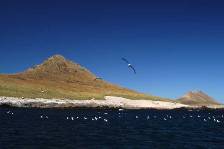 Most of the albatrosses nest on the two central islands, Grand Jason and Steeple Jason, with over 50 000 pairs on Grand and over 100 000 pairs on Steeple.
The closer we got, the more albatrosses we saw, both in the air and forming great rafts on the sea, countless white shapes bobbing on a sheet of blue.
Although there was quite a swell running the sea was oliy smooth and there was hardly a breath of wind so we decided to cruise slowly along the south coasts of both islands, where the colonies are.
The colonies on Grand were impressive enough, with several main areas stretching up a steep hillside from the sea and thousands of birds in the air.
Most of the albatrosses nest on the two central islands, Grand Jason and Steeple Jason, with over 50 000 pairs on Grand and over 100 000 pairs on Steeple.
The closer we got, the more albatrosses we saw, both in the air and forming great rafts on the sea, countless white shapes bobbing on a sheet of blue.
Although there was quite a swell running the sea was oliy smooth and there was hardly a breath of wind so we decided to cruise slowly along the south coasts of both islands, where the colonies are.
The colonies on Grand were impressive enough, with several main areas stretching up a steep hillside from the sea and thousands of birds in the air.
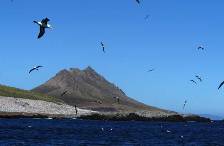 But on Steeple the scale of the colony was simply staggering.
It stretches several unbroken miles, the nests so closely packed that it looks like a solid swathe of white along the lower slopes of the island.(see photos)
We were able to creep in to within a few hundred meters of the rocks and had what we think may be the best possible view of the colony as a whole, as from the shore side it would be difficult to approach through the dense tussac grass.
Everywhere we looked were albatrosses, filling the sky as they soared above the colony.
It was a magnificent sight and we felt priviliged to be there, even just for a few hours.
By late afternoon the wind was starting to pick up and we had a nice sail back to Hope Harbour, just opposite Westpoint Island.
But on Steeple the scale of the colony was simply staggering.
It stretches several unbroken miles, the nests so closely packed that it looks like a solid swathe of white along the lower slopes of the island.(see photos)
We were able to creep in to within a few hundred meters of the rocks and had what we think may be the best possible view of the colony as a whole, as from the shore side it would be difficult to approach through the dense tussac grass.
Everywhere we looked were albatrosses, filling the sky as they soared above the colony.
It was a magnificent sight and we felt priviliged to be there, even just for a few hours.
By late afternoon the wind was starting to pick up and we had a nice sail back to Hope Harbour, just opposite Westpoint Island.
|
| |
 Hope Harbour is another special place, with a good anchorage in a little cove on the south side.
Several thousand Gentoo penguins nest on a grassy plain, said to be one of the largest colonies in the world.
As the fine weather continued we spent several days with the penguins and every evening watched them coming ashore on the beach.
There was a large number of non-breeding birds, perhaps last years chicks, and they loved to play in the shallow water, bathing, chasing, porpoising and rushing in and out of the water.
They are also insatiably curious and whenever we sat still for a few minutes they would come sidling up to us, the bravest ones wassling to within a few feet (see photo).
Hope Harbour is another special place, with a good anchorage in a little cove on the south side.
Several thousand Gentoo penguins nest on a grassy plain, said to be one of the largest colonies in the world.
As the fine weather continued we spent several days with the penguins and every evening watched them coming ashore on the beach.
There was a large number of non-breeding birds, perhaps last years chicks, and they loved to play in the shallow water, bathing, chasing, porpoising and rushing in and out of the water.
They are also insatiably curious and whenever we sat still for a few minutes they would come sidling up to us, the bravest ones wassling to within a few feet (see photo).
|
| |
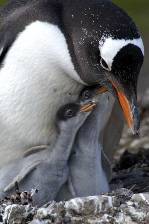 In the colony the pace was picking up with eggs hatching every day and many chicks now a few days or even a week old.
Their soft, silvery down is like crushed velvet and their skins seem too loose, making them look like little sacks waiting to be filled.
From the moment they lift their heads, they begin begging for food and never refuse a meal.
We saw some receiving so much food it was hard to know where they put it, but their tummies appear to expand like balloons!
In the colony the pace was picking up with eggs hatching every day and many chicks now a few days or even a week old.
Their soft, silvery down is like crushed velvet and their skins seem too loose, making them look like little sacks waiting to be filled.
From the moment they lift their heads, they begin begging for food and never refuse a meal.
We saw some receiving so much food it was hard to know where they put it, but their tummies appear to expand like balloons!
 Just around the corner on the cliffs there was a small colony of Rockhoppers.
Sitting on the rocks to watch them we began to hear a faint cheeping and wondered whether hatching had begun....
sure enough, we soon saw an adult bending down to feed and found two nest where there were chicks, another exciting discovery (see photo).
Even smaller than the Gentoos, but just as hungry, these chicks have darker grey down and although two chicks often hatch, it is unusual for both to survive.
Just around the corner on the cliffs there was a small colony of Rockhoppers.
Sitting on the rocks to watch them we began to hear a faint cheeping and wondered whether hatching had begun....
sure enough, we soon saw an adult bending down to feed and found two nest where there were chicks, another exciting discovery (see photo).
Even smaller than the Gentoos, but just as hungry, these chicks have darker grey down and although two chicks often hatch, it is unusual for both to survive.
|
| |
|


 From Pebble Island we had a brisk sail to Saunders Island, passing through Pebble Sound and past Keppel Island on a rare day of settled weather - a mere 15 knots from the southwest.
Saunders Island, the second largest offshore island in the Falklands, is a fantastic place with an abundance of wildlife.
For the past 5 days we've been exploring, anchoring in various bays.
But the highlight has definitely been The Neck (see photo), a narrow stretch of low land that almost cuts the island in two.
With a lucky break of almost 48 hrs of very calm wind we were able to anchor on the north side, off the mile long sandy beach, and land the dinghy ashore, normally made difficult by the swell.
From Pebble Island we had a brisk sail to Saunders Island, passing through Pebble Sound and past Keppel Island on a rare day of settled weather - a mere 15 knots from the southwest.
Saunders Island, the second largest offshore island in the Falklands, is a fantastic place with an abundance of wildlife.
For the past 5 days we've been exploring, anchoring in various bays.
But the highlight has definitely been The Neck (see photo), a narrow stretch of low land that almost cuts the island in two.
With a lucky break of almost 48 hrs of very calm wind we were able to anchor on the north side, off the mile long sandy beach, and land the dinghy ashore, normally made difficult by the swell.
 Hundreds of Gentoo penguins nest near the beach and spend much time trudging to and fro between their colony and the sea.
For the first time we saw them 'surfing' in the breaking waves as they come ashore and they really seem to be enjoying themselves as they catch a wave, ride it in and burst from the surf in showers of spray.
As they leave the water they tend to congregate in groups to preen and rest (see photo).
Magellanic penguin burrows were everywhere in the sandy soil.
Although these penguins are somewhat shy and secretive they are also quite inquisitive and often peer out of their burrows at you, turning their heads from side to side to look first with one eye and then the other.
On the hillside overlooking the beach was a large colony of mixed Rockhopper penguins and Imperial shags going about their business in raucous chaos.
Rockhoppers love fresh water to drink and bathe in and a little stream running down the hill was a great place to watch them.
Endless squabbles broke out over who's turn it was to splash in a favourite pool and if we sat still for long enough these cheeky little characters sidled right up to us to stare with their bright red eyes.
Hundreds of Gentoo penguins nest near the beach and spend much time trudging to and fro between their colony and the sea.
For the first time we saw them 'surfing' in the breaking waves as they come ashore and they really seem to be enjoying themselves as they catch a wave, ride it in and burst from the surf in showers of spray.
As they leave the water they tend to congregate in groups to preen and rest (see photo).
Magellanic penguin burrows were everywhere in the sandy soil.
Although these penguins are somewhat shy and secretive they are also quite inquisitive and often peer out of their burrows at you, turning their heads from side to side to look first with one eye and then the other.
On the hillside overlooking the beach was a large colony of mixed Rockhopper penguins and Imperial shags going about their business in raucous chaos.
Rockhoppers love fresh water to drink and bathe in and a little stream running down the hill was a great place to watch them.
Endless squabbles broke out over who's turn it was to splash in a favourite pool and if we sat still for long enough these cheeky little characters sidled right up to us to stare with their bright red eyes.

 It was a very special moment for us when we saw our first breeding Black-browed albatrosses.
The Falkland Islands are the most important breeding area in the world for these magnificent, but endangered, birds.
An estimated 11,000 pairs nest along the north shore of Saunders Island, spread out in small groups and to sit near a colony and watch these beautiful birds in action was a real privilige.
It was a very special moment for us when we saw our first breeding Black-browed albatrosses.
The Falkland Islands are the most important breeding area in the world for these magnificent, but endangered, birds.
An estimated 11,000 pairs nest along the north shore of Saunders Island, spread out in small groups and to sit near a colony and watch these beautiful birds in action was a real privilige.
 Nests are up to a foot high, pillars built of mud and grass spaced just out of reach of the next bird and often perched precariously on the edge of the cliff.
We saw several pairs involved in nest building with one bird sitting on the nest while carefully plastering mud around the edge with its bill while the other bird transported fresh mud and grass to within reach (see photo).
Sometimes this was done over quite a distance and the birds picked up mud piece by piece, tossing it back over their shoulders and then repeating the process again and again.
Although many birds had single, pale cream coloured eggs, we also noticed quite a few empty nests with birds sitting.
These birds often took part in elaborated displays, pairs of birds circling a nest with tails fanned and feet stamping, crooning to each other and touching bills (see photos above).
We surmised that these may be young birds that are not breeding this season but are practicing for next....
For more information on why Black-browed albatrosses are endangered and the campaign to save them, and all albatross species, visit www.savethealbatross.net
Nests are up to a foot high, pillars built of mud and grass spaced just out of reach of the next bird and often perched precariously on the edge of the cliff.
We saw several pairs involved in nest building with one bird sitting on the nest while carefully plastering mud around the edge with its bill while the other bird transported fresh mud and grass to within reach (see photo).
Sometimes this was done over quite a distance and the birds picked up mud piece by piece, tossing it back over their shoulders and then repeating the process again and again.
Although many birds had single, pale cream coloured eggs, we also noticed quite a few empty nests with birds sitting.
These birds often took part in elaborated displays, pairs of birds circling a nest with tails fanned and feet stamping, crooning to each other and touching bills (see photos above).
We surmised that these may be young birds that are not breeding this season but are practicing for next....
For more information on why Black-browed albatrosses are endangered and the campaign to save them, and all albatross species, visit www.savethealbatross.net













































